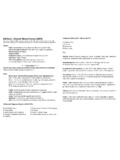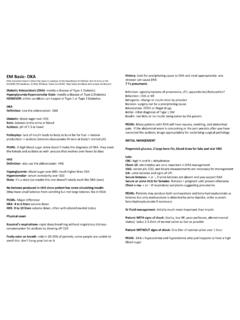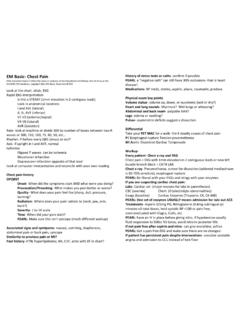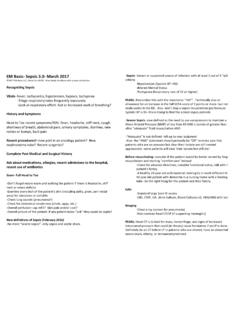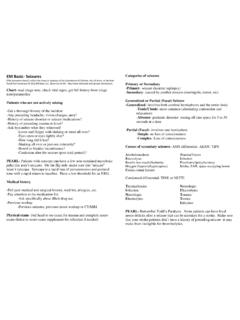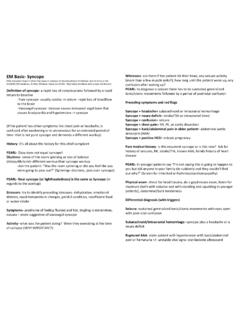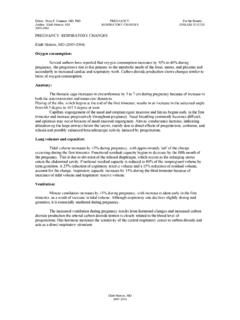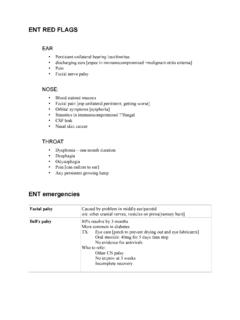Transcription of 47 Epistaxis Show Notes - EM Basic
1 Copyright: UpToDate 2014. EM Basic Epistaxis (This document doesn t reflect the views or opinions of the Department of Defense, the US Army, or the SAUSHEC EM residency, 2014 EM Basic , Steve Carroll DO. May freely distribute with proper attribution) Epidemiology: Bimodal age distribution. Most cases in the 2- 10 or 50- 70 year- old age groups. More common in winter, possibly due to dry climate, frequency of URI s. Allergic rhinitis and use of nasal medications are risk factors.
2 Etiology: Majority result from digital trauma (nose- picking). Other types of trauma or recent surgery may be responsible. Intranasal cocaine use may also provoke bleeding. Pearl: Consider a foreign body if bleeding is accompanied by purulent discharge. Blood Supply: 90% are anterior bleeds emanating from Kiesselbach s plexus (see diagram above). 10% are posterior bleeds from posterolateral branches of the sphenopalatine or carotid arteries. Triage note / initial assessment: Assess patency of airway, vital signs and evaluate for hemodynamic stability.
3 Resuscitate and escalate care as needed. HPI: Assess timing, severity, frequency, etc. Screen for risk factors, coagulation disorders or anticoagulant use, recent trauma, surgery, or conditions that predispose to bleeding. Ask about intranasal medication or substance use (cocaine). Ask about associated medical problems that may be exacerbated by bleeding (CAD, pulmonary disease), or symptoms (chest pain, SOB). Pearls: Epistaxis is the most common presenting symptom among patients with hereditary hemorrhagic telangiectasia (Osler- Weber- Rendu).
4 Bleeding can be difficult to control in these patients. Consider blood dyscrasias (von Willibrand disease / hemophilia) or other chronic conditions (cirrhosis, HIV) in patients with difficult to control or recurrent bleeds. Recurrent, unilateral bleeding is concerning for neoplasm. Initial Tamponade: o Patient blows out blood and clots (use PPI) o Spray nares with oxymetazoline. o Pinch alae together and hold for 10 minutes. Pearl: Have the patient bend forward at waist to avoid swallowing blood.
5 Exam: Assess VS, mental status, and airway as above. Perform a general physical exam as appropriate. The focused exam of the nose requires the patient to blow out clots. Pretreatment of the nares with lidocaine soaked plegits will aid the nasal exam. Use of a nasal speculum is recommended. Attempt to find the bleeding vessel(s). Inspect Kiesselbach s plexus for bleeding, ulceration, or erosion. Assess the oropharynx for sanguineous drainage. Brisk bleeding that does not stop with direct pressure and cannot be visualized may be from a posterior source.
6 Work- up: Labs are not routinely required, but anticoagulation studies should be obtained for patients on anticoagulants or with known coagulopathy. Severe bleeds or signs of anemia or hemodynamic instability require a hematocrit and possibly type & screen/crossmatch and large bore IV placement, depending on severity. Treatment Anterior bleeds If bleeding has stopped with pressure, observe for 30 minutes. It may be possible to discharge the patient with prophylactic topical antibiotic ointment applied to nasal mucosa multiple times daily for three days.
7 If bleeding is unsuccessfully controlled by direct pressure, but slows or stops temporarily (and an anterior source can be visualized), proceed to cautery. Chemical cautery is usually performed in the ED w/silver nitrate sticks. First, anesthetize with topical lidocaine, then dab the applicator gently around the suspected source of bleeding. Avoid prolonged cautery and bilateral cautery to prevent septal perforation. Pearl: Attempts to cauterize actively bleeding vessels are futile.
8 If bleeding is swift after direct pressure or cautery attempts unsuccessful, proceed to nasal packing. Several types of packing are available. Pretreat with lidocaine and topical vasoconstrictor such as oxymetazoline. Coat the tampon with bacitracin ointment, then insert the nasal tampon directly back into the nasal cavity. Expand the tampon with saline solution applied with a syringe. Occasionally it may be necessary to pack the contralateral nare to provide pressure against the initial packing, but this is discouraged given risk of septal necrosis.
9 Posterior bleeds Refractory bleeding suggests a posterior bleed. These bleeds are much more serious and require ENT consult and hospitalization. They most often occur in elderly patients or those with bleeding disorders, or on anticoagulation. Posterior bleeds require insertion of a balloon catheter. A 10 or 14 French Foley can be used if a standard balloon catheter is not available, but most ED s have balloon catheters available. This is an uncomfortable procedure and may require sedation.
10 Prepare the patient by providing necessary sedation and topical anesthesia. Advance the catheter along the floor of the nasal cavity fully. Inflate the posterior balloon with 10 mL sterile saline. Retract the catheter until it lodges firmly against the posterior choana. When the posterior balloon is seated, inflate the anterior balloon with 30 mL of sterile saline. The amount of saline added may have to be adjusted for patient comfort. Pearl: Do NOT use petroleum based lubricant with balloon catheters, as these substances may degrade the catheter rubber.
